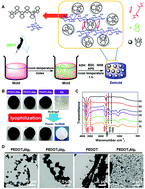A conductive PEDOT/alginate porous scaffold as a platform to modulate the biological behaviors of brown adipose-derived stem cells†
Abstract
The development of three-dimensional conductive scaffolds is vital to support the adhesion, proliferation and myocardial differentiation of stem cells in cardiac tissue engineering. Herein, we describe a facile approach for preparing a poly(3,4-ethylenedioxythiophene)/alginate (PEDOT/Alg) porous scaffold with a wide range of desirable properties. In the PEDOT/Alg scaffold, chemically crosslinked alginate networks are formed using adipic acid hydrazide as the crosslinker, and PEDOT is synthesized in situ in the alginate matrix simultaneously. PEDOT exists in the alginate matrix as particles and its morphology can be modulated by adjusting the ratio of PEDOT/alginate. The results also show that the swelling properties, degradation behaviors, mechanical strength and conductivity of the PEDOT/Alg scaffold can be controlled via adjusting the PEDOT/alginate ratio. The introduction of PEDOT can overcome the brittle nature of the pure alginate scaffold. Moreover, the PEDOT/Alg scaffold exhibits excellent conductivity (as high as 6 × 10−2 S cm−1). The introduction of PEDOT improves the protein absorption capacity of the alginate scaffold. To explore its potential application in cardiac tissue engineering, brown adipose-derived stem cells (BADSCs) are seeded in the prepared PEDOT/Alg porous scaffold. The results suggest that the PEDOT/Alg porous scaffold can support the attachment and proliferation of BADSCs. Moreover, it is beneficial for the cardiomyogenic differentiation of BADSCs, especially under electrical stimulation. Overall, we conclude that the PEDOT/Alg porous scaffold may represent an ideal platform to modulate the biological behaviors of BADSCs.



 Please wait while we load your content...
Please wait while we load your content...